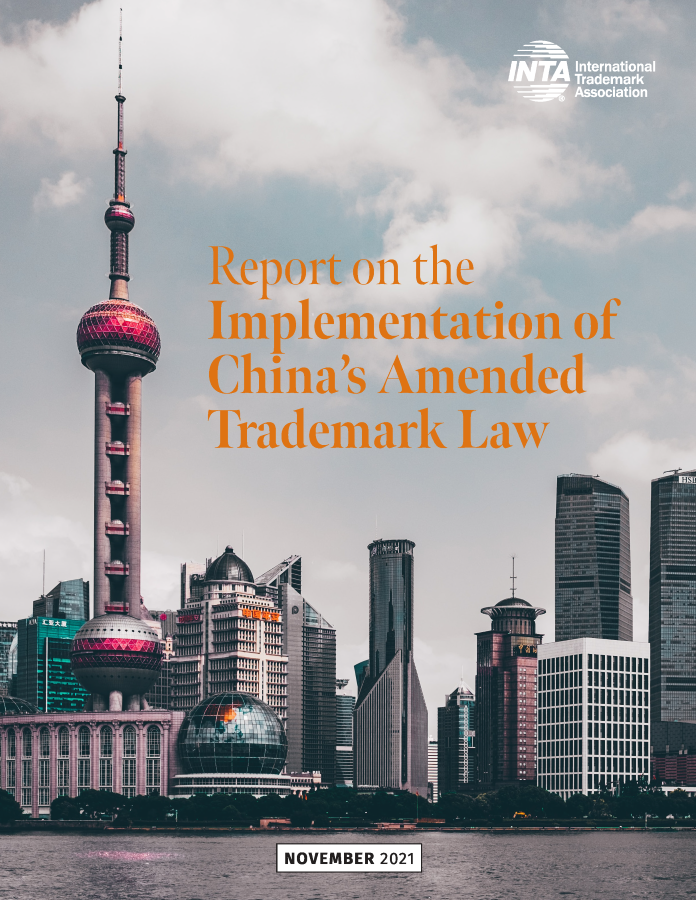INTA News
INTA Issues Report on the Implementation of China’s Amended Trademark Law
Published: December 8, 2021

Yongjian Lei Wanhuida Intellectual Property Beijing, China Trademark Office Practices Committee—China Subcommittee
 INTA’s Trademark Office Practices Committee, China Subcommittee, has issued a Report on the Implementation of China’s Amended Trademark Law. It provides critical insights into the impact on the pace and shape of intellectual property (IP) rights protection in China since the 4th Amendment of the Law came into force in 2019.
INTA’s Trademark Office Practices Committee, China Subcommittee, has issued a Report on the Implementation of China’s Amended Trademark Law. It provides critical insights into the impact on the pace and shape of intellectual property (IP) rights protection in China since the 4th Amendment of the Law came into force in 2019.
The four-section Report involved two years of work by Subcommittee members and is based on an analysis of feedback provided by 100 INTA members—brand owners and practitioners—in China and globally who responded to a survey sent out by the Subcommittee. The Report focuses on the main policy changes contained the 4th Amendment, namely: trademark warehousing, trademark squatting, trademark agency discipline, and increased penalties against IP infringement.
Marking the most significant finding, the Report reveals that the amended law and relevant corresponding provisions have offered powerful tools to curb trademark warehousing. This is illustrated by evidence that the top trademark filers have expressed genuine interest in using their marks in commerce.
Although trademark warehousing and skyrocketing trademark filings in China—up from 7.5 million in 2019 to 9.3 million in 2020—are not innately or causally linked, it remains to be seen whether the efforts to curb trademark warehousing will continue to act as a strong deterrent to the proliferation of trademark filings in the future.
Regarding trademark squatting, survey respondents were generally optimistic that the amended law would result in a decrease in bad-faith filings.
Although the squatters are becoming more cunning in how they cover their tracks, which imposes more difficulties on brand owners for investigation and evidence collection, the survey reveals that the success rates in opposition and invalidation cases have been significantly improved in recent years. Notably, since earlier this year, there has been an increase in cases where penalties are equivalent or almost close to what the law allows.
The Report notes that the amended law and other administrative regulations and rules more closely regulate trademark agencies—important players in the trademark ecosystem. On one hand, the respondents agree that stricter regulation on agencies implemented in the 4th Amendment is necessary and helpful. On the other hand, they expressed concern about over-demanding restrictions, such as the circumstances in which the agencies are held contributorily negligent and therefore liable for alleged bad-faith filings, and to what extent the supervisory authorities, including local Administrations for Market Regulations, can regulate trademark agencies.
Furthermore, while the amended law raises the statutory damages to RMB 5 million (approximately US $780,000) from RMB 3 million (approximately US $470,000), the respondents believe there is more to be done. More than half (52.6 %) believe the effect on the court’s post-amended law rulings on compensation amounts are “average.” Nonetheless, since then, there has been a clear increase in court cases upholding punitive damages, and the Supreme People’s Court and the Beijing High Court have issued judicial guidance on calculation methods for punitive damages.
The Report provides an overview of the legislative changes, analysis, and comments on the survey results, and draws conclusions based on court judgments and local enforcement punishment records. It also offers practice tips to help brand owners and practitioners globally navigate the IP system in China.
The Report, which represents a milestone of successful committee advocacy work, will help guide INTA in its policy work on future revisions of China’s Trademark Law.
Although every effort has been made to verify the accuracy of this article, readers are urged to check independently on matters of specific concern or interest.
© 2021 International Trademark Association
This website uses cookies so that we can provide you with the best user experience possible. Cookie information is stored in your browser and performs functions such as recognising you when you return to our website and helping our team to understand which sections of the website you find most interesting and useful.
To find out more please see our Cookies Policy and Privacy Policy.
These cookies are used to identify a user’s browser as the visitor goes from page to page on the Site. These are session cookies, which means that the cookie is deleted when you leave the Site. It is an integral piece of the Site software and used to let the server know which users are on the Site at any given time and make certain parts of the Site easier to use.
|
|
If you disable this cookie, we will not be able to save your preferences. This means that every time you visit this website you will need to enable or disable cookies again.
These cookies are used to collect information about how visitors use our Site. The cookies collect information in anonymous form, including the numbers of visitors to the Site, where visitors have come to the Site from, the pages they visited and how they have interacted with tools on the Site like search and embedded media players. We use the information to compile statistical reports of our users’ browsing patterns so that we can improve the Site.
|
|
Please enable Functionality Cookies first so that we can save your preferences!
These cookies are used to deliver advertising relevant to the interests of visitors to our Site. They are persistent, which means they will remain on your device after you leave the Site.
- Facebook (Ad Pixel)
- Google (Ad Pixel)
- LinkedIn (Ad Pixel)
- Quattro Anonymous
Please enable Functionality Cookies first so that we can save your preferences!
